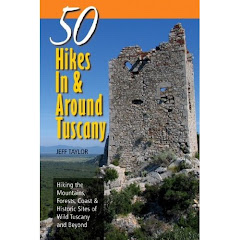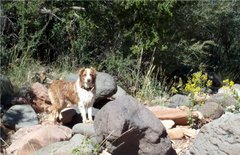Sorry everyone for the long break on this blog. We have been on the road for the last week as we do the drive from Sequim, WA to Kanab, UT. I will be now posting some snippets from our adventures and then next week we'll get serious about our daily adventures in canyon country. For those looking for a hike description, I'll get back to that once we get established in Kanab.
On Sept 11th we hit the road in our travel trailer for the canyon country. We stopped for two days in Portland, OR to visit with friends of Linda. Visiting Linda's friend Juma, we went down to Silver Falls State Park to see the beautiful falls that drop over a series of flood basalt benches.
After leaving Gresham, then we set out on the grand adventure. Our first stop along the way was Farewell Bend State Park on the Oregon/Idaho border along the Snake River. This was the spot where people on the Oregon Trail left the Snake River after having followed it for hundreds of miles and headed out toward the Blue Mountains and eventually to the Willamette Valley.
The next day we drove down the Snake River plain through Boise and towards Twin Falls. This part of Idaho is extremely boring and I can not imagine living out there. We did stop briefly at Hagerman Fossil Beds to see the 3.5 million year old horses they dug up in old lakebed sediment along the Snake River.
This area also has large areas of rounded basalt rock from the Bonneville floods 15,000 years ago when Lake Bonneville overtopped the ridges and rushed into the Snake River plain as it eroded a channel into the hills.
Then it was onto Twin Falls and the spectacular 200 foot cliffs of Shoshone Falls in the Snake River Canyon. This is the end of the historic salmon migration, as they could not possibly ascend those falls. In fact, those falls create a biogeographic separation between Pacific oriented fish species such as salmon, rainbow trout, sturgeon, and others and those with Rocky Mountain/Great Basin affinities such as Bonneville cutthroat trout. Only when flood waters created temporary lakes in the canyon were fish able to pass this barrier. After a night at the nice little county campground of Rock Creek Park.


After a night at the nice little county campground of Rock Creek Park, we headed south into Northern Utah to Golden Spike National Historic Site, where the Union Pacific and Southern Pacific railways finally met from east and west. They had two circa 1960’s replica steam engines on display and did demonstration runs with them. Hilina was in heaven, as they went by and she waived her little Thomas the Tank Engine toy at the conductor.
That night we camped at Antelope Island State Park in the middle of the Great Salt Lake, the last remnant of the ancient Lake Bonneville that once covered over half of Utah. It is a beautiful grassland full of proghorns, bison, and coyotes yelping at dusk. We had pronghorns running right by the campsite.
We went for a quick swim in the warm Great Salt Lake, which due to its extreme salinity that is some 4-8 times saltier than the ocean, makes you extremely bouyant. I also discovered that the flat oolitic rocks on the shore are some of the most amazing skipping rocks I have ever seen. The extra heavy salt waters, in combination with the light, flat rocks, makes for rocks that seem to float across the surface until all momentum is lost.
So, what is oolitic rock? It is sand that has been glued together with calcium carbonate, sodium chloride, and brine shrimp excrement into layer rocks. They are fairly soft and pretty easily to break apart. You can tell they will become (or already are) layers of sedimentary rock that future geologists will study.
Next we traveled down to Timpanogos Cave National Monument in the Wasatch Front range. Just south of Salt Lake City, this cave system is unique due to being a fault cave. It was formed when a fault on the mountain moved, creating a large crack in the mountain that allowed rainwater to flow down and deposit calcite formations. It is also home to some really unique formations I have never seen in any other caves before including, helictites which resemble soda straws but curl around in all directions like curly fries. We were told that Timpanogos Cave has one of the largest collection of these formations in the world.


To get to the cave requires a 1.5 mile hike that climbs 1000 feet through stands of white fir and canyon maple. It is located up the beautiful American Fork Canyon, which gives a great peak at the geology of the Wasatch Front Range. The cave tour is lead by National Park Rangers and lasts about 1 hour. Hilina loves caves and was having a blast inside. But, the boring park ranger kept going "blah blah blah" and stopping us while Hilina wanted to continue. Linda had her hands full. At one point, the ranger was talking and Hilina blurted out "No No No".

That night we camped at Utah Lake State Park near Provo. Utah Lake is another, albeit smaller, remnant of Lake Bonneville. However, due to the inflow of freshwater from the mountains and an outlet has remained mostly fresh, as compared to the Great Salt Lake. The Great Salt Lake is so salty because evaporation greatly outpaces inflow and there is no outlet for it. Thus, any salts that flow into the basin remains in that basin and has been accumulating for over 20,000 years. As evening approached, a vicious looking storm formed over the Wasatch Front and looked like it might come over us. However, it eventually broke up and we never saw any rain.
From Utah Lake, we then made the 5 hour run to Kanab, which will be our home base for the next month. On the next post, I will tell you about our lovely adventures at Crazy Horse RV park and why we are paying more to stay at Hitch-N-Post RV Park instead.






























































